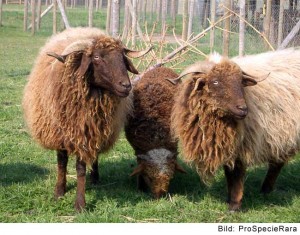Walliser Landschaf (CH)
Description
The breed is medium to large-framed and rather light with long Roman head. Both sexes carry spiral horns, ewes’ horns are finer than male horns: The rough fleece is reddish-brown or black, turning grey at old age. It consists of long and rather straight wool hair. Hind legs are woolly to the ankle joints, front legs woolles. The ankles are of medium length and strong with very hard claws. The animals are strictly non-seasonal. Age at first lambing is 17 months.
General and History
It is an autochthones breed of the Upper Valais, its origin remains in the dark. It is supposed that the breed has descended from the Kupfer, an extinct breed. In the 1980ies, only few individuals had been left so that Pro Specie Rara initiated a conservation programme. Herdbook since 1986.
Distribution in the past and today
In 1985 when the breed was nearly extinct, PSR started a conservation project. Today, the breed is spread in entire Switzerland with stable population development.
Utilization
Use of meat and wool and for landscape management.
Keeping
Valais Blacknose is quiet and friendly, well adapted to meagre locations and rough high-mountain conditions. They are able to climb well and move safety in high mountain terrain, undemanding robust and even able to thrive on low-quality food. Strongly developed herd instinct. Loyalty to location when kept on Alpine pastures.
Breeding aims
Whilst animals are kept extensively, breeding aims to conserve the animals ‘ resistance, ability to move in difficult terrain, health, good fertility and rearing performance, longevity and medium fattening potential on rough feed basis.
Performance
Body weight: 60-90kg (m), 50-75 (w)
Withers height: 65-75 (m), 60-70cm (w)
Processing and products
Animals up o the age of three years for fresh meat, afterwards as a sausage. Wool suitably to the felt.
Literature
· ProSpecieRara: Nutztierkompass, Basel, 2012 (https://www.prospecierara.ch/de/shop/article/nutztierkompass)
· Schafrassen in den Alpen, Antje Feldmann, Ursula Bietzker, Dr. Christian Mendel, Gesellschaft zur Erhaltung von alten und gefährdeten Haustierrassen e.V. - GEH, 2005
· Brochure «Ressources zoogénétiques de l’agriculture suisse», 20.09.2021, Office Fédéral de l'Agriculture, OFAG (texte français)








